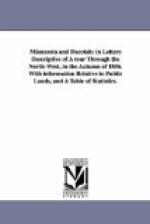The territory of Minnesota according to its present boundaries embraces an area of 141,839 square miles exclusive of water;— a domain four times as large as the State of Ohio, and twelve times as large as Holland, when her commerce was unrivalled and her fleets ruled the sea. Its limits take in three of the largest rivers of North America; the Mississippi, the Missouri, and the Red River of the North. Though remote from the sea board, ships can go out from its harbors to the ocean in two if not three different channels. Its delightful scenery of lakes and water-falls, of prairie and woodland, are not more alluring to the tourist, than are its invigorating climate and its verdant fields attractive to the husbandman. It has been organized seven years; and its resources have become so much developed, and its population so large, there is a general disposition among the people to have a state organization, and be admitted into the Confederacy of the Union.[1] A measure of this kind is not now premature: on the contrary, it is not for the interest of the general government any longer to defray the expenses of the territory; and the adoption of a state organization, throwing the taxes upon the people, would give rise to a spirit of rivalry and emulation, a watchfulness as to the system of public expenditures, and a more jealous regard for the proper development of the physical resources of the state. The legislature which meets in January (1857), will without doubt take the subject into consideration, and provide for a convention to frame a constitution.
[1 On the 9th of December Mr. Rice, the delegate in congress from Minnesota, gave notice to the house that he would in a few days introduce a bill authorizing the people of the territory to hold a convention for the purpose of forming a state constitution.]
This being the condition of things, the manner in which the territory shall be divided— for no one can expect the new state will embrace the whole extent of the present territory— becomes a very interesting question. Some maintain, I believe, that the territory should be divided by a line running east and west. That would include in its limits the country bordering, for some distance, on the Missouri River; possibly the head of navigation of the Red River of the North. But it is hardly probable that a line of this description would give Minnesota any part of Lake Superior. Others maintain that the territory should be divided by a line running north and south; say, for instance, along the valley of the Red River of the North. Such a division would not give Minnesota any of the Missouri River. But it would have the benefit of the eastern valley of the Red River of the North; of the entire region surrounding the sources of the Mississippi; and of the broad expanse which lies on Lake Superior. The question is highly important, not only to Minnesota, but to the territory which will be left outside of it; and it should be decided with a due regard to the interests of both.[1]




